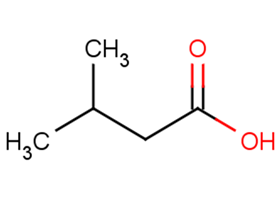
3-Methylbutanoic acid
CAS No. 503-74-2
3-Methylbutanoic acid( isovaleric acid | Delphinic acid | 3-Methylbutyric acid | Isopentanoic acid | β-methylbutyric acid )
Catalog No. M20269 CAS No. 503-74-2
3-Methylbutanoic acid is a naturally occurring aroma compound found in Bartlett pear brandies vanilla beans rape-honey and banana.
Purity : >98% (HPLC)
 COA
COA
 Datasheet
Datasheet
 HNMR
HNMR
 HPLC
HPLC
 MSDS
MSDS
 Handing Instructions
Handing Instructions
| Size | Price / USD | Stock | Quantity |
| 100MG | 37 | In Stock |


|
| 200MG | Get Quote | In Stock |


|
| 500MG | Get Quote | In Stock |


|
| 1G | Get Quote | In Stock |


|
Biological Information
-
Product Name3-Methylbutanoic acid
-
NoteResearch use only, not for human use.
-
Brief Description3-Methylbutanoic acid is a naturally occurring aroma compound found in Bartlett pear brandies vanilla beans rape-honey and banana.
-
Description3-Methylbutanoic acid is a naturally occurring aroma compound found in Bartlett pear brandies vanilla beans rape-honey and banana.
-
In Vitro——
-
In Vivo——
-
Synonymsisovaleric acid | Delphinic acid | 3-Methylbutyric acid | Isopentanoic acid | β-methylbutyric acid
-
PathwayOthers
-
TargetOther Targets
-
RecptorOthers
-
Research Area——
-
Indication——
Chemical Information
-
CAS Number503-74-2
-
Formula Weight102.13
-
Molecular FormulaC5H10O2
-
Purity>98% (HPLC)
-
SolubilityWater: 20 mg/mL;DMSO: Soluble
-
SMILESCC(C)CC(O)=O
-
Chemical Name3-Methylbutanoic acid
Shipping & Storage Information
-
Storage(-20℃)
-
ShippingWith Ice Pack
-
Stability≥ 2 years
Reference
1.Blasioli S et al. Identification of volatile markers in potato brown rot and ring rot by combined GC-MS and PTR-MS techniques: study on in vitro and in vivo samples. J Agric Food Chem. 2014 Jan 15;62(2):337-47.
molnova catalog



related products
-
Giganteone A
The herbs of Curcuma wenyujin Y.H.Chen & C.Ling.
-
S-Dihydrodaidzein
S-Dihydrodaidzein is an enantiomer of dihydrodaidzein which is involved in equol biosynthesis in a lactic acid bacterium, Lactococcus sp. strain.
-
BU 226 hydrochloride
BU 226 hydrochloride demonstrates affinity for imidazoline (I) receptors, in particular the I2 binding site with a Ki of 1.4 nM. BU 226 hydrochloride showed low (microM) affinity for alpha 2-adrenoceptors.



 Cart
Cart
 sales@molnova.com
sales@molnova.com


